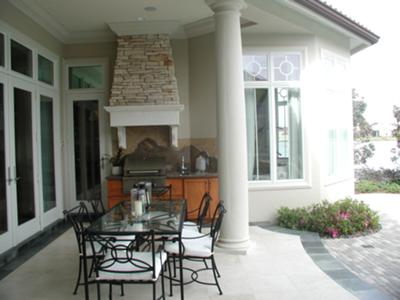Outdoor Kitchen Barbeque Grill Safety
Building an outdoor kitchen involves many a challenge including decisions about plenty of small details.
Certainly safety is paramount when playing with fire and you don't want surprise problems down the road.
So, below are tips and answers to readers questions about fire-proofing, choices for non-flammable materials, insulation jackets and general safety considerations when installing an outdoor kitchen barbecue grill.
QUESTION:
I have outdoor kitchen design ideas for our Moose Lodge.I want to put it on the back pad behind the building, with a grill, oven, deep fryer, stovetop and fridge.
Do I need a fire system hood?
We live in Florida. The area will be screened in with a couple of picnic tables.
ANSWER:
If the barbecue area is completely enclosed with roof and screened walls and smoke could get trapped by the roof, then you'll want to install some type of ventilation system.Or fashion a chimney in the roof top to allow the smoke and heat to vent up naturally.
At minimum you may want some directional fans attached to walls or ceiling to help direct smoke out of the structure.
However, if you mean an emergency sprinkler type system for putting out a fire, that is a question for your local code inspector.... especially if this is a public space.
Certainly having a hand-held fire extinguisher permanently located near the cooking area is a super idea.
But given you'll have several appliances (including hot oil) in what may be a smallish space, then an installed, automatic fire-suppression system is something to seriously consider for the safety of your cook and guests.
Return to Outdoor Kitchen Questions & Answers.
Outdoor Kitchen Exhaust Fan
by Sandy Vieille
(Tampa, Fla)
QUESTION:
We are building an outdoor kitchen. We have purchased a 33 inch outdoor barbeque with 48000 BTUs and the entire kitchen will be under roof on our lanai.Do we require an exhaust fan / blower for this installation?
If so, can we use 300CFM vs 600 CFM. We currently use a portable CharBroil grill and have never had any damage to our lanai ceiling.
The exhaust/blower is not required by our county.
ANSWER:
Sandy, certainly you want to ensure a safe grilling area and being overly-cautious is always a good idea.That said... if you currently grill under the lanai without any unpleasant smoke build-up or damage to the ceiling, then it's not likely to change unless you change how and what you typically cook in your outdoor kitchen. And a fan will add noise.
High heat pan frying/stir frying will create a lot of smoke, but if you are usually grilling meats and veggies then you should be fine.
Also, if in the future you do find it too smoky a fan is something that can be added to the outdoor kitchen fairly easily. If you do decide to do it, I'd go with the 600 cfm. The 300 is likely to be too weak.
Return to Outdoor Kitchen Questions & Answers.
Outdoor Kitchen Backsplash Behind Grill
by Bobby
(Charleston, SC)
QUESTION:
I am building an outdoor kitchen next to our shed and the roof hangs over a foot or two.I want to protect the wall and the over hang...
What can I do? What type of material do I use?
ANSWER:
I imagine you'd like to protect the wall and overhang from flame and heat, but also food and grease from the barbecue.Any non-flammable material will do the job for protecting the wall behind/around the barbecue, so long as you prepare the shed wall to support it properly.
Of course, you'll want to choose something with a smooth surface for easy clean-up.
Fire-retardant materials include:
- Stainless steel sheeting
- Squares of tin decorative tile
- Granite, travertine tile, any kind of stone tile
- Ceramic tile or glass tile
- Bricks or rough cut stone wall cladding
- Or go simple, low-budget industrial chic and use corrugate metal panels... easy install and maintenance.
With so many possibilities I can't say you should definitely do A or B. Especially without seeing your set-up or design style.
The overhang shouldn't be an issue. The barbeque grill housing itself provides the majority of fire-protection. It's a controlled flame covered by the lid for most of the cooking, so risk is small.
However, if the overhang is unusually low, then consider covering it right above the bbq with something easy to install, like stainless steel or tin sheets.
And really, unless the grill is right up against the shed wall, then the chance of accidental fire or excessive food splatter is pretty slim.
If it's a relatively large wall, then you have an opportunity to do a cool design with tile. That's probably what I'd lean toward.
Get creative with the design and let your personality show. Style-wise there isn't really a "wrong" thing to do, so I say install a material and design that you'll be happy looking at and maintaining for the next 5-10 or more years.
Comments for Outdoor Kitchen Backsplash Behind Grill
|
||
|
||
Best Gas Grill Insulation for Outdoor Kitchen
QUESTION:
I am planning an outdoor patio kitchen with a bbq in a covered area (11 feet high).The grill will go against a wooden wall, and on a wooden frame.
What type of fireproof material (and how thick) should be used as insulation between the wall and barbecue?
Can tile be used? What's most cost efficient?
ANSWER:
Ideally you should purchase a grill that includes an insulating jacket to protect the wood outdoor kitchen framing from heat.In addition, use granite, porcelain or ceramic tile or metal sheeting to cover any other exposed, flammable surfaces above, behind or to the sides of the barbecue.
Ceramic tile is typically the most cost-efficient and relatively easy to install, however, you need to use the proper materials and technique to ensure a water-tight surface.
Obviously, if water gets to the wood frame it will rot out quickly and ruin your whole set up.
Thickness of the fire-retardant material is not too important. Excessive heat is not the issue.
The protection needed is to prevent an open flame from catching the frame on fire and simply covering the frame with non-flammable surface will prevent this.
Now, your local building code may have something to say about this issue though, so be sure to check that out. You may not care now, but when you go to sell the house it could get flagged.
Return to Outdoor Kitchen Questions & Answers.
Outdoor Kitchen Drop In Grill Placement
by Dennis Dettra
(Richboro pa)
QUESTION:
Does the lip of the drop in BBQ go on top of the countertop or under the countertop?One way looks better the other is practical for removal of the grill later.
ANSWER:
Without seeing your countertop and the barbecue it's difficult to answer definitively, however, typically even a drop in will not have the countertop run in front of the grill due to depth and controls.The outside countertops will be cut to butt up on each side of the BBQ.
But if your's will have the countertop run in front, then I imagine the controls and grill sit above the countertop surface.
So, I'd put the lip above the countertop, which would facilitate later replacement.
Comments for Outdoor Kitchen Drop In Grill Placement
|
||
|
||
|
||





